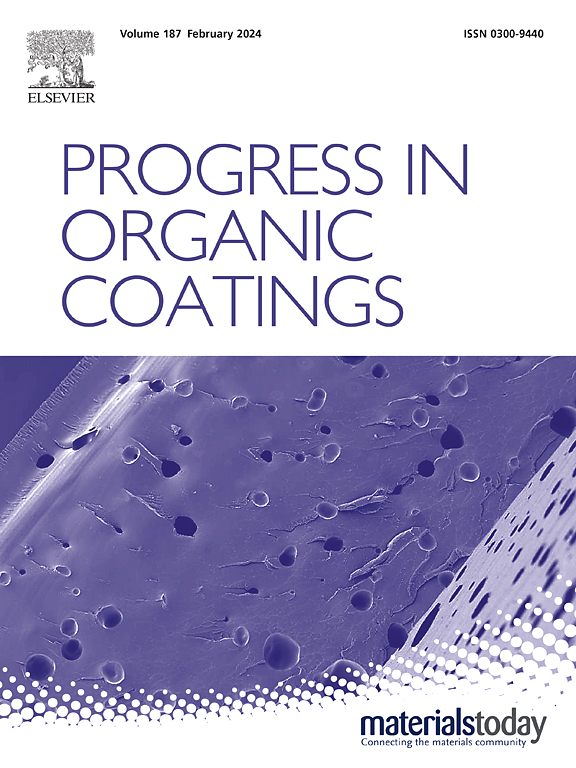Coral biomimetic PDMS marine antifouling coating based on the intrinsic antibacterial and fluorescent response synergistic strategies
IF 6.5
2区 材料科学
Q1 CHEMISTRY, APPLIED
引用次数: 0
Abstract
The applicability of polydimethylsiloxane (PDMS)-based marine antifouling coatings is restricted by their limited mechanical properties and static antifouling capabilities. In this study, we have developed a coral biomimetic PDMS marine antifouling coating, designated as PDMS-DAF-x-AMC, which employs synergistic antifouling strategies based on intrinsic antibacterial and fluorescent response mechanisms. Here, ‘x’ represents the amount of 3,4-diaminofurazan (DAF) incorporated into the formulation. Hydroxyl-terminated polydimethylsiloxane was employed as the primary matrix with DAF serving as chain extenders, 7-amino-4-methylcoumarin (AMC) acting as the end-capping agent and zinc ions as the coordinating metal. The dosages of DAF are 0.0, 0.1, 0.2, and 0.3 g, respectively, while the dosage of AMC is consistently maintained at 0.03 g. The supramolecular interactions, including hydrogen bonds and coordination bonds within the PDMS network enhance the mechanical properties, adhesion strength, and self-healing capabilities. Furthermore, the inherent antibacterial activity of DAF, combined with the fluorescence response of AMC synergistically imparts the coating with superior fouling-resistant properties with a bacteriostatic efficiency exceeding 99 % and maintaining a minimum diatom density of 18 ± 11 diatoms mm−2. Also, the low surface energy ranging from 21.11 to 24.86 mJ·m−2 gave the coating excellent self-cleaning properties and promoted the fouling-release performance. This study aims to introduce an innovative design concept for the advancement of high-performance PDMS antifouling coatings through the incorporation of various environmentally sustainable biomimetic antifouling strategies.

基于内在抗菌和荧光反应协同策略的珊瑚仿生PDMS海洋防污涂料
聚二甲基硅氧烷(PDMS)基船舶防污涂料的机械性能和静电防污能力有限,限制了其适用性。在本研究中,我们开发了一种珊瑚仿生PDMS海洋防污涂层,命名为PDMS- daf -x- amc,该涂层采用基于内在抗菌和荧光响应机制的协同防污策略。这里,“x”表示在配方中加入3,4-二氨基脲(DAF)的量。以端羟基聚二甲基硅氧烷为主要基体,DAF为扩链剂,7-氨基-4-甲基香豆素(AMC)为端盖剂,锌离子为配位金属。DAF的剂量分别为0.0、0.1、0.2、0.3 g, AMC的剂量一直维持在0.03 g。PDMS网络中的氢键和配位键等超分子相互作用增强了其力学性能、粘附强度和自愈能力。此外,DAF固有的抗菌活性与AMC的荧光响应协同作用,使涂层具有优异的耐污性能,抑菌效率超过99%,并保持最低硅藻密度为18±11硅藻mm−2。低表面能(21.11 ~ 24.86 mJ·m−2)使涂层具有良好的自清洁性能,提高了脱垢性能。本研究旨在通过结合各种环境可持续的仿生防污策略,为高性能PDMS防污涂料的发展引入一种创新的设计理念。
本文章由计算机程序翻译,如有差异,请以英文原文为准。
求助全文
约1分钟内获得全文
求助全文
来源期刊

Progress in Organic Coatings
工程技术-材料科学:膜
CiteScore
11.40
自引率
15.20%
发文量
577
审稿时长
48 days
期刊介绍:
The aim of this international journal is to analyse and publicise the progress and current state of knowledge in the field of organic coatings and related materials. The Editors and the Editorial Board members will solicit both review and research papers from academic and industrial scientists who are actively engaged in research and development or, in the case of review papers, have extensive experience in the subject to be reviewed. Unsolicited manuscripts will be accepted if they meet the journal''s requirements. The journal publishes papers dealing with such subjects as:
• Chemical, physical and technological properties of organic coatings and related materials
• Problems and methods of preparation, manufacture and application of these materials
• Performance, testing and analysis.
 求助内容:
求助内容: 应助结果提醒方式:
应助结果提醒方式:


